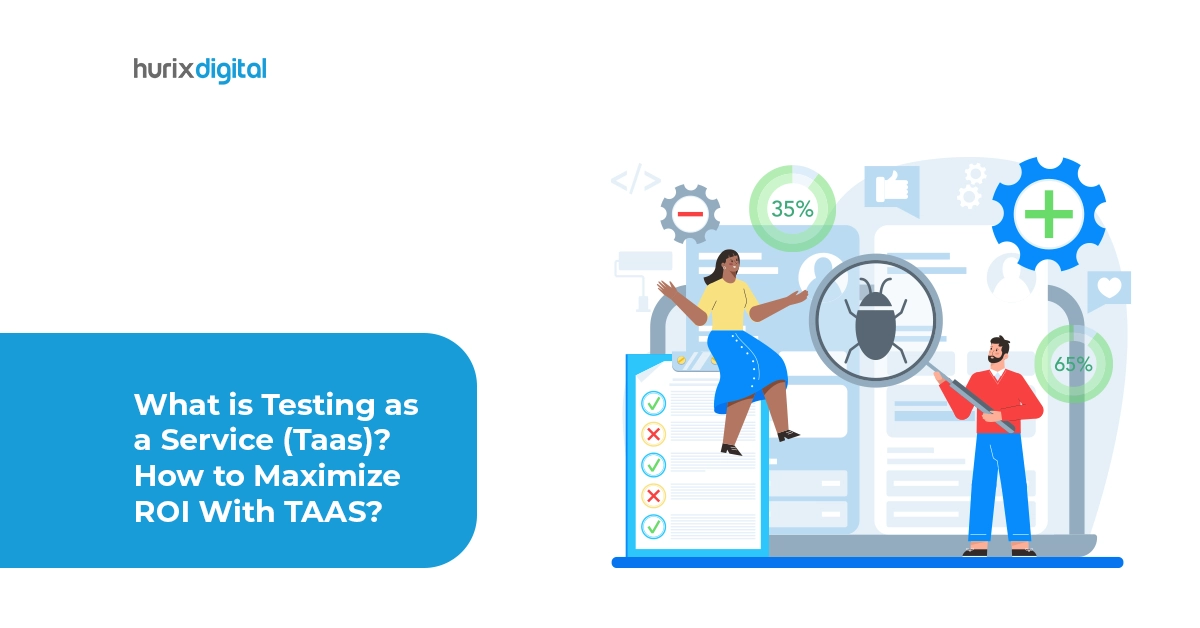
What Is Testing as a Service (TaaS)? Know Types & Benefits of Taas!
Summary
Learn about Testing as a Service (TaaS), a cloud-based approach to software testing that offers flexibility, scalability, and cost efficiency by outsourcing testing tasks.
Today, everything from automobiles to smart home appliances has pieces of code powering them, bending the scenes. Malfunctions of any degree can significantly impact a brand’s reputation and, in more severe instances, lead to costly litigations.
One way to avoid the scenarios mentioned above is to perform exhaustive testing of each piece of code before deployment. While most organizations have in-house testing teams, these teams may need more expertise and on-demand scalability.
This is where Testing as a Service (TaaS) comes into play. This blog will explain what TaaS testing is and how it can help you maximize your ROI.
Table of Contents:
- What Is TaaS?
- What are the Types of Testing TaaS Undertakes?
- How Does TaaS Work?
- What are the 3 Benefits of TaaS Testing?
- Summing It Up
What Is TaaS?
Testing as a Service is a cloud-based, third-party service organizations use to outsource their testing activities. It is a pay-as-you-go model where the organization buys all the necessary resources, such as testing software, tools, or supporting infrastructure.
These software testing services come into their own when an organization does not have the resources to invest in the infrastructure or the workforce required to develop a full-fledged house testing team or needs on-demand expertise for specific testing needs.
Although it is a relatively new approach to testing that has been gaining traction in recent years, the TaaS market was valued at $4.58 Billion as of 2022. Based on current trends, it is projected to hit $10.57 Billion by 2030.
What are the Types of Testing TaaS Undertakes?
Application testing is a vital aspect of the Software Development Life Cycle. Based on where in the SDLC the project is, various types of testing come into the picture, which can be primarily classified into two major categories.
1. Functional Testing
Functional testing, as the name implies, focuses on testing the “function” of a software application. TaaS service providers can be roped into performing various functional tests, such as
- Unit Testing
- Integration Testing
- Regression Testing
- User Acceptance Testing
These tests essentially focus on what the software does.
2. Non- Functional Testing
Non-functional testing focuses on the non-functional aspects of a software application, such as its performance, usability, and security. Here, TaaS service providers can provide testing solutions for:
- Load Testing
- Performance Testing and
- Security Testing
Also Read: Why Tech-as-a-Service (TaaS) is Gaining Popularity over the Traditional Approach?
How Does TaaS Work?
The process of working with a TaaS provider typically involves the following steps:
The first and foremost step is choosing the right service provider for your specific needs. TaaS service providers are abundant today. However, not everyone will have the particular expertise you are looking for, the specialized tools you need, or match your budget requirements.
Once you have a service agreement in place, the rest of the process goes as follows:
- Requirement analysis: The process starts by discussing the scope and the objectives and establishing the expectations of the testing project. Based on this, the TaaS service provider proposes a testing plan.
- This includes identifying the types of testing you need, the test cases you want to execute, and the expected timelines. Once the plan has been approved, the process moves on to the next phase.
- Setting up the test environment: The TaaS provider then sets up the test environment that matches the client’s production environment and all the software and tools required to execute the testing the project has agreed on.
- Test execution: The TaaS service provider then executes the test cases as discussed and agreed upon based on the testing plan. The testing method here can be either manual or automated, depending on the specifics of the testing requirements.
- Evaluation: The TaaS provider evaluates the test results and defects against the predefined quality criteria and metrics and provides the client with a detailed report and test logs.This usually contains feedback and recommendations on how to improve the software quality and performance, along with the following information:
- The types of tests that were performed.
- The results of each test.
- Any bugs that were found.
- Recommendations for improvement.
- Reiteration and Test Closure: The client then fixes any issues/bugs that were detected during the testing process and then provides the updated product for another round of comprehensive tests. The process repeats till the application is error-free and ready to be moved to production.
TaaS testing, however, is not required or mandatory for every aspect of testing. You can consider availing the services of a testing services provider if:
- You do not have the in-house expertise to perform a specific series of tests.
- You need to scale up your testing requirements at short notice.
- You need access to better testing tools and software.
What are the 3 Benefits of TaaS Testing?
Digital transformation is taking place in every industry today, and with that comes a growing demand for software and programs to facilitate it.
Testing as a Service model comes into its own at this juncture, where quick and error-free deliveries are the need of the hour. Here is now:
1. Reduced Time to Market
Testing as a Service providers are experts in their field. Since their primary focus, unlike in-house development teams, is only on this one aspect of the SDLC, they help businesses speed up the testing process, reducing a product’s time to market.
Their expertise in this one aspect also ensures more comprehensive and rigorous testing, which results in better overall quality of the software product.
2. Access to Cutting Edge Technology
In-house development teams work on fixed budgets, and their testing teams may not have the luxury of working with the latest tools in the market.
TaaS testing solutions, on the other hand, do. Having access to the latest software and tools is also a plus in their marketing strategy to be able to distinguish themselves from their competition to win over clients.
3. Cost Savings
When business outsource their testing to software testing services, they can benefit from significant cost savings associated with the resources, the tools, and the licenses required to perform extensive in-house testing.
Capital can then be diverted into the development aspect of their projects. TaaS services also give you the flexibility to scale up or scale down your testing requirements as needed, which again eliminates the capital investment into the infrastructure required to do the same in-house.
Also Read: How to Choose the Right Application Training for Your IT Company
Summing It Up
TaaS testing is an excellent alternative if you need quick and easy access to testing expertise and tools that your in-house team lacks.
The icing on the cake is that you get all of the above at a fraction of the cost compared to attempting to scale up and acquire the resources and infrastructure needed for niche testing skills. If improving the quality of your product while improving time to market is something you are looking for, TaaS services are your best bet.
Hurix Digital is a reliable testing partner for all your needs. With over 20 years of experience, our holistic approach to testing guarantees an error-free final product. We undertake a wide range of testing, including automation, API, functional, and mobile app testing, to name a few.
Contact Us to know more.

Vice President – Digital Content Transformation. He is PMP, CSM, and CPACC certified and has 20+ years of experience in Project Management, Delivery Management, and managing the Offshore Development Centre (ODC).






